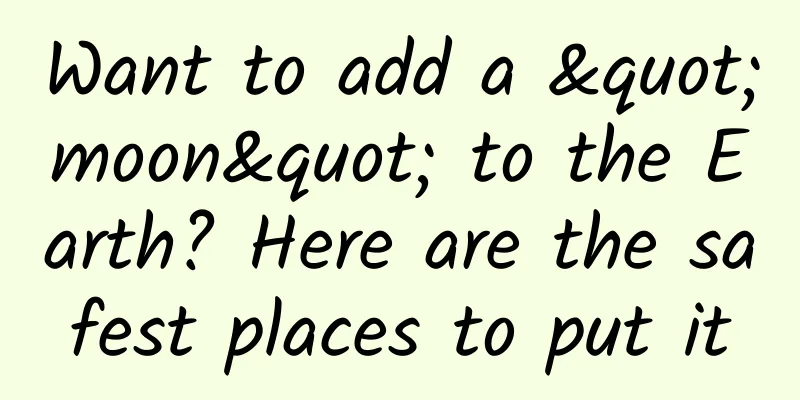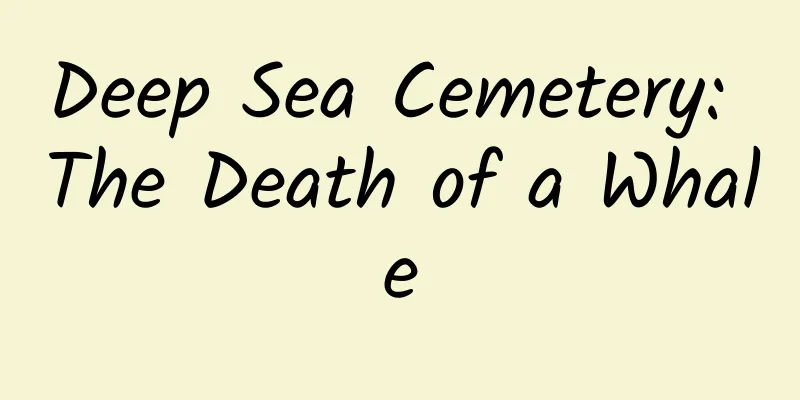Want to add a "moon" to the Earth? Here are the safest places to put it

|
During the Spring Festival, the movie "The Wandering Earth 2" and the TV series "The Three-Body Problem" "satisfied" many audiences who love science fiction. While watching the drama and the movie, everyone also had a great interest in the relevant scientific terms and related problems that appeared in these two works, such as Roche limit and the three-body problem. In the past two days, Zhang Chaoyang, the founder of Sohu, also talked about some designs in "The Wandering Earth 2" in his offline physics class, and also suggested that "The Wandering Earth 3" could develop the plot based on Lagrange points . Image source: Screenshot from Sina Weibo For astronomy enthusiasts, the term "Lagrange point" may be familiar. It is named after the French scientist Lagrange. The communication relay satellite Queqiao of Chang'e 4 was located at a Lagrange point to ensure communication between Chang'e 4 and the earth. Queqiao, located at the Lagrange L2 point, provides communication support for Chang'e 4. Image source: China Aerospace Science and Technology Corporation So the question is, what exactly is the "Lagrange point"? Why is it named after Lagrange? Let's find out today. 01 Europe's greatest mathematician Lagrange Joseph-Louis Lagrange is a French-Italian mathematician and astronomer. His main achievements are in the field of mathematics, and he used mathematical analysis methods to study mechanics and astronomy. When many people were studying calculus, they were burned by the various test questions derived from Lagrange's mean value theorem, which seemed to be simple. In addition to Lagrange, there are three other giants in the basic university courses: Laplace, Fourier and Poisson. The first one was his colleague, and the latter two were his students... Lagrange, Image source: Wikipedia To be precise, Lagrange cannot be called "Italian", and the territory of Italy was fragmented throughout his life. He was born in Turin, which belonged to the Kingdom of Sardinia under the rule of the Savoy royal family. Lagrange's father was the financial director of the Office of Public Affairs and Defense in Turin. He should have been quite wealthy, but his father used his money on failed financial speculation, so Lagrange's family was not well off. His father planned for him to become a lawyer, and Lagrange seemed to have accepted his fate. He studied at the Turin Academy, and his favorite subject was classical Latin. At first, he had no interest in mathematics and found Greek geometry boring. But when he read a paper by Halley - yes, the Halley of Halley's Comet - that introduced the use of mathematics to determine the focus of a lens, he suddenly felt that his life had a new direction - perhaps the entire mathematical community should thank Lagrange's father for his failed speculation, because according to Lagrange: If I had money, I might not have devoted myself to mathematics. In addition to his father who had “failed in investment”, Lavoisier also helped Lagrange a lot. In 1786, Lagrange left Berlin and went to work at the Paris Academy of Sciences. Just three years after arriving in Paris, the French Revolution broke out. In 1793, the National Convention decided to clean up the Academy of Sciences, and Lavoisier’s strong protection saved Lagrange from expulsion. Portrait of Lavoisier, Image source: Wikipedia But Lavoisier himself was unfortunate. On May 8, 1794, he was sent to the guillotine. Lagrange said sadly: It only takes a moment to cut off this head, and it will take a hundred years to find such an outstanding head. Lagrange's outstanding contributions include Lagrange's theorem in group theory, the four-square sum theorem in number theory, Lagrange's multiplier method in calculus, and Euler-Lagrange equations in variational calculus. He pioneered Lagrangian mechanics in analytical mechanics and promoted the mechanical analysis of astronomy. As the first member of the Weights and Measures Committee of the French Bureau of Longitude, Lagrange promoted the formulation of the metric system (the predecessor of the International System of Units). The units we are familiar with today, such as meters and kilograms, are based on the initial definitions at that time. If we look at the names of his contemporaries: Lavoisier, Laplace, Legendre, Herschel, Coulomb, Volt, Watt, Kant... we can basically feel his significance to modern science. 02 Key points in the aerospace field Lagrange point With the development of science and technology, Lagrange's name is no longer limited to textbooks. Now, in the news related to space research and aerospace technology, the public often hears a word, that is, "Lagrange point". For example: the Queqiao relay satellite operates near the Lagrange point of the Earth-Moon system, providing communication services between the back of the moon and the earth; the James Webb Space Telescope is placed at the Lagrange point to observe the universe in the early days of the "Big Bang"... So, which point is the "Lagrange point"? Before understanding Lagrange points, let us first think about an interesting question: Taking the Earth and the Sun as an example, where should we place a small celestial body on the Earth's orbital plane so that when this small celestial body revolves around the Sun, it will have the same orbital period as the Earth and its relative position with the Sun and the Earth will remain unchanged? Please think about this for a minute... This is actually a set of special solutions to the three-body problem. , is a special state of translation. As early as 1767, Euler found three special solutions under this restriction. Euler, Image source: Wikipedia Later, in 1772, Lagrange, an informal but true student of Euler, calculated two more. The positions corresponding to these five special solutions near the orbit are called "Lagrange points" (also known as libration points), and are numbered L1, L2, L3, L4 and L5 respectively. Schematic diagram of the translation of five Lagrange points, image source: Wikipedia These five numbers are not randomly assigned, each number corresponds to a unique position . Take the sun and the earth as an example: L1 is on the line between the Sun and the Earth and is closer to the Earth. L2 is on the extended line of the line connecting the Sun and the Earth, on one side of the Earth, or in other words, in the direction of the Earth's shadow. L3 is on the extension of the line connecting the Earth and the Sun, on the side of the Sun opposite to the Earth, and its distance from the Sun is basically equal to the distance between the Sun and the Earth. L4 and the Sun and the Earth form an equilateral triangle, guiding the Earth's orbit. L5 forms an equilateral triangle with the sun and the earth, and moves along with the earth. L1 to L3 are the results obtained by Euler, and L4 and L5 are the results obtained by Lagrange. Five Lagrange points. Image credit: NASA It can be seen that L1 and L2 are inside and outside the Earth's orbit, respectively. If we do not consider the Earth, the inner circle should run faster than the Earth, and the outer circle should run faster than the Earth. However, there is an "if". The Earth's gravity will say to the small celestial body in L1, "Wait for me!" and to the small celestial body in L2, "Follow closely, don't fall behind!" As a result, although they are at different distances from the sun, L1, the Earth, and L2 are running on the ecliptic plane at the same angular velocity. The small celestial bodies in L1 always hover on the day side of the Earth, while the small celestial bodies in L2 always stay on the night side. This is really interesting. To be precise, the five Lagrange points all revolve around the common center of mass of the Sun and the Earth . This center of mass is about 450 kilometers from the center of the Sun to the Earth, which is negligible compared to the radius of the Sun of 696,340 kilometers. Seeing this, many friends may assume that the Lagrange points are between the Sun, the Earth, and the Moon, right? In fact, they are not. As long as it is a similar celestial system, there are such solutions. However, in this article, the Lagrange points refer to the points from L1 to L5. 03 At the Lagrange point What happens if you launch a small satellite? Lagrange points are ideal solutions in mathematics, but in the real world, we cannot just put the detector at a Lagrange point and forget about it. The stability of the five Lagrange points is different, just like an apple on the top of your head or at the bottom of a bowl, its performance to external interference is completely different. If a small celestial body placed in L1, L2 or L3 is disturbed by other celestial bodies (very common, such as the moon) and deviates a little, it will continue to deviate and go farther and farther; while if it is placed in L4 or L5, as long as the mass ratio of the sun to the earth is greater than 25 (of course), it can draw a bean-shaped curve and float back even if it is pulled away by the perturbation of other planets. Therefore, if we put the probe in L1, L2 or L3, we need to prepare more propellant for it to adjust its position and attitude, while for L4 or L5, we can save a lot. However, L4 and L5 have other troubles: because they are very stable, many natural small celestial bodies tend to gather here, and the probability of the probes arranged here being damaged is much higher than that at the other three points . Based on the characteristics of Lagrange points, people have designed some tailor-made plans for space exploration of special nature. 1. Lagrange point - L1 L1 is between the Sun and the Earth, so the probes for studying the Sun are placed here. They are about 1.5 million kilometers away from the Earth, outside the lunar orbit, and will never fall into the shadow of the Earth or the Moon, so they can continuously observe the Sun. The Solar and Heliospheric Observatory (SOHO) and the Deep Space Climate Observatory (DSCOVR) are deployed here. After China's Chang'e 5 orbiter completed its lunar landing mission, it worked overtime and flew to the Sun-Earth L1 to carry out some solar exploration missions because the project was progressing smoothly and there was sufficient propellant. SOHO working at L1. Image source: NASA As we said, L1 is not a stable point . And if the probe is placed precisely at L1, the solar radiation will come from the same direction and drown out the signal sent by the probe (this phenomenon is called "solar eclipse"). Therefore, the probe placed at L1 actually circles around L1 along a halo orbit (HALO orbit). 2. Lagrange point - L2 L2 is in the direction of the Earth's shadow and is also about 1.5 million kilometers away from the Earth. The Earth and the Moon seen from here are both dark, and this place is located at the tail of the Earth's magnetosphere, and the interference of the solar wind is also low, so this position is suitable for quietly admiring the night sky with your back to the sun . Some tasks such as detecting the afterglow of the "Big Bang" and gazing at the ultra-deep space of the universe can be carried out here. The Wilkinson Microwave Anisotropy Probe (WMAP), Planck Surveyor (Planck), and James Webb Space Telescope (JWST) were successively arranged here. The tasks of the first two are to investigate the cosmic microwave background radiation, and JWST is used to study the formation and evolution of the first stars and galaxies after the "Big Bang". The James Webb Space Telescope orbits the Earth in L2. Image source: Wikipedia L2 in the Earth-Moon system is also an interesting location. Our Queqiao rover is also working here. It is always on the far side of the Moon, orbiting the Earth synchronously with the Moon. In this way, it can transmit information from Chang'e 4 and Yutu 2 on the far side of the Moon to the Earth. Queqiao will circle around L2, so the Earth can always receive its signals without being blocked by the Moon. 3. Lagrange point - L3 Currently, there are no spacecraft working in L3. There is the sun between here and the earth, and the information obtained from L3 cannot reach the earth directly. Moreover, it is difficult to maintain stability in this position . There is no earth to protect it, and Venus often passes by in front of it, which seriously interferes with the orbit. However, science fiction novels are particularly fond of this place, and often describe an "anti-earth" here, where a group of aliens are ambushed and secretly plot against us under the cover of the sun. So, what if there is really an anti-earth here? Don't worry, there are probes that have come here to check, and there is indeed nothing. 4. Lagrange points - L4 and L5 L4 and L5 also have the characteristics of eternal daylight, and the stability of these two points is easy to maintain, and they are also very suitable for studying the sun. However, they are too far away from the earth (equal to the distance between the sun and the earth), and L1 is basically enough for studying the sun. There is no urgent need to develop them at present. Some probes have been here, but they did not stay for long, such as the Spitzer Space Telescope (SST) and the Solar Terrestrial Relations Observatory (STEREO). L4 and L5 form equilateral triangles with the Earth and the Sun respectively. Image source: researchgate If these two points are really used, then L5 is more valuable than L4. Because L5 is located upstream of the sun's rotation. When a solar storm breaks out, L5 can know it four days in advance before the earth and send an early warning to the earth. The European Space Agency's Vigil is going to put a probe here. However, its main purpose is not to warn of solar storms, but to study solar storms in collaboration with another probe placed in L1: when L1 is hit head-on, L5 can provide a side view. By the way, before it was named "Vigil", the name of this plan was "Lagrange". Science fiction novels and comics also prefer L4 and L5 because they are far from the Earth, have stable locations, have large amounts of natural asteroids nearby, are rich in minerals, and can be used for both attack and defense. They are common story backgrounds for interstellar colonization themes. I hope that one day, the fantasies in these science fiction novels can be realized. Author: Qu Jiong, a popular science writer whose works have been published in the National Museum, the National Space Administration, etc. Reviewer: Liu Xi, researcher at Beijing Planetarium The cover image and the images in this article are from the copyright library Reproduction of image content is not authorized |
<<: World Leprosy Day丨Preventable, curable and not scary!
>>: Is a child's laughter a disease? Be careful of this tumor!
Recommend
Programmer's nightmare: Are you afraid of encountering such a bug?
[[156934]] The bug is this: This bug only occurs ...
The 2023 Turing Award is out! Why is the "randomness" of computers so important?
Last night, the Association for Computing Machine...
Where will diesel cars go? Shikoku mayors say they will be banned from the road
Recently, the mayors of Paris, Athens, Madrid and...
What is the secret weapon for reducing carbon dioxide in the atmosphere?
In recent years, people seem to have become accus...
BAIC New Energy's stock price plummeted 37% on the first day of its backdoor listing. Where should investors break out in the future?
On September 27, BAIC New Energy, which was liste...
Rare! These days, you must get up early!
According to astronomical science experts, from A...
The prosperity of the underground world can also bring unexpected treasures
The "fire" in the center of the earth i...
What to do when a programmer is tired
It is not uncommon for programmers to lose their ...
Tujia.com's big data precision marketing solution!
Tujia.com Big Data Precision Marketing Solution P...
The popularity of keywords has dropped. What is Apple trying to do?
Since mid-July, many CPs and ASO ers have reporte...
He searched the Pan-Himalayan region to find the grass for the lamb chops.
Speaking of Labiatae You may wonder What are Lami...
9 models to teach you how to quickly master content marketing
This article summarizes the 9 major architecture ...
Yang Guozheng's Eye Method + Sanyuan Naqi (3 sets 5.07G)
Yang Guozheng's Shape Parent Eye Method + San...
If the taste of Sichuan pepper is so strange, why was the highest level of favor in ancient times called "the favor of the pepper room"?
People often say that only love and food are not ...
No wonder I don’t like carrots, they are from the same family as coriander!
Audit expert: Shi Jun Doctor of Botany, well-know...









